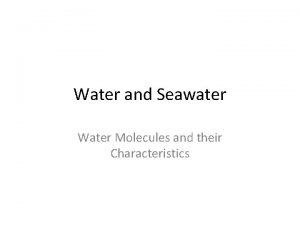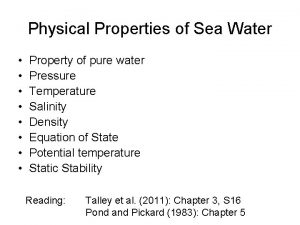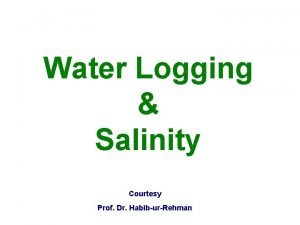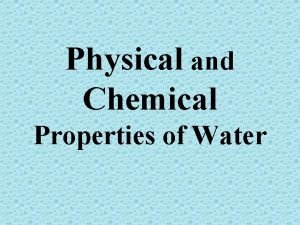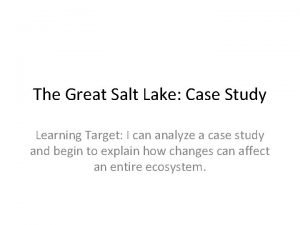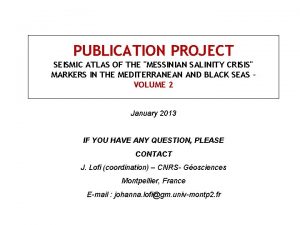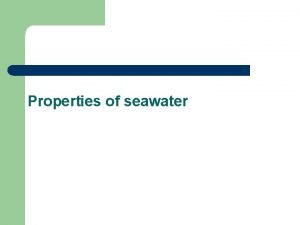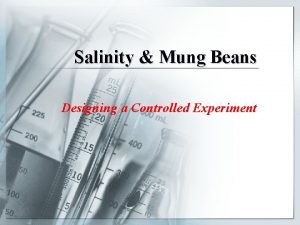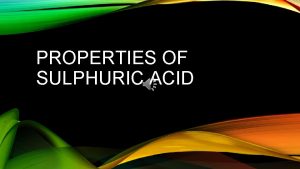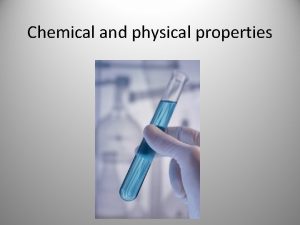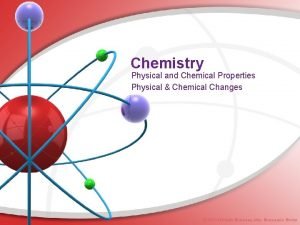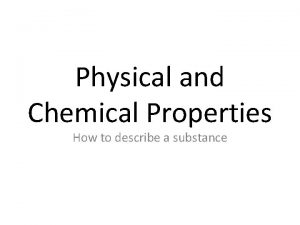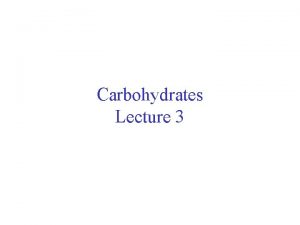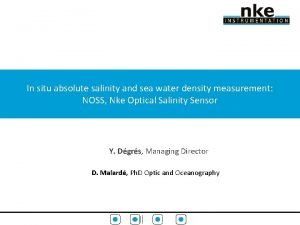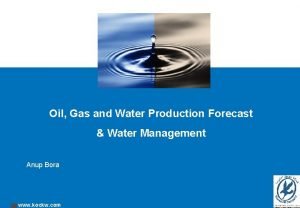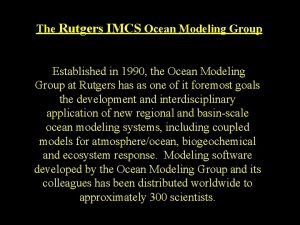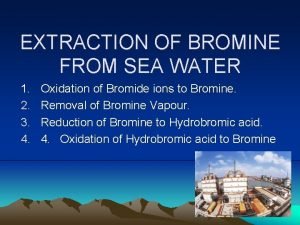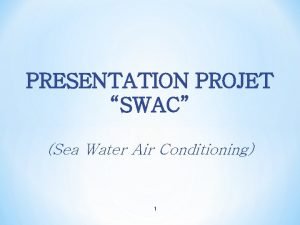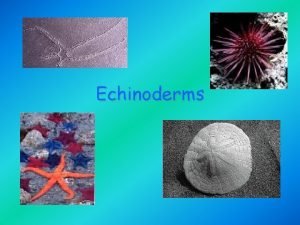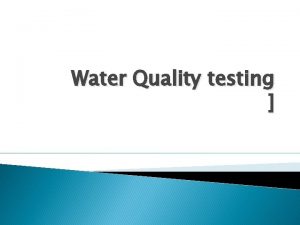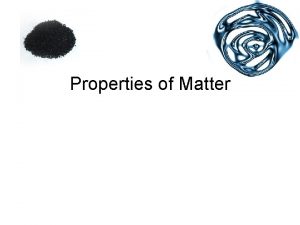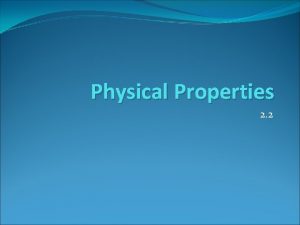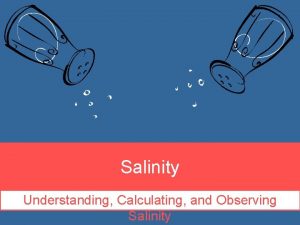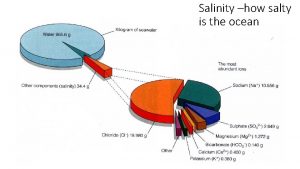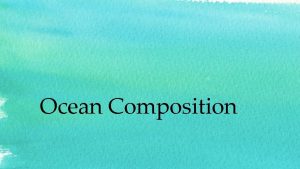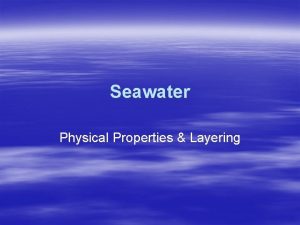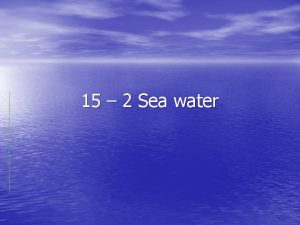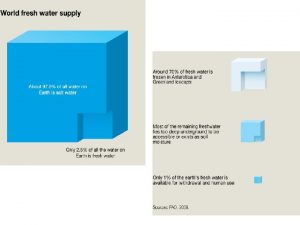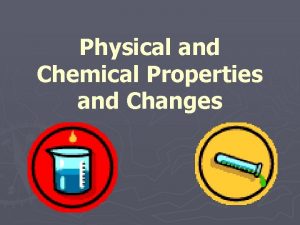Physical properties of sea water Intoduction Salinity and










































- Slides: 42

Physical properties of sea water Ø Intoduction Ø Salinity and Chlorinity Ø Temperature and themal properties of sea water Ø Colligative and other properties of sea water Ø Residence time of constituents in sea water Ø Sea ice Ø Sound velocity and radiation Ø Sea surface salinity Ø Seawater temperature Ø Water mass

Introduction • Many of the processes that occur in the oceans depend on the physical properties of sea water. The conduction of heat, absorption of light, transmission of sound, formation of waves, tides, ice, currents and water masses are some of the important physical features of ocean water. Sea water contains pure water as well as salts, dissolved gases, organic substances and undissolved suspended particles. The presence of salts and other substances in sea water greatly influence the various characteristics of sea water. Hence, an understanding of the physical properties of sea water is necessary to study the various processes that occur in the ocean. The forces that cause circulation of water in the ocean arise from changes in the physical properties of that water. • Physical properies like temperature and salinity directly affect the density, buoyancy and stability of seawater and consequently the motion of water in the ocean basins. The physical properties of seawater also strongly influences the behaviour of heat and light in the ocean.

The unit of physical oceanography deals with the following chapters • • • 1. Salinity and chlorinity 2. Temperature of seawater 3. thermal properties of seawater 4. Colligative and other properties of seawater 5. Residence time of constituents in seawater 6. Properites of sa ice 7. Transmission of sound 8. absorbtion of radiation 9. Eddy conductivity 9. Duffyusivity and viscosity 10. General distribution of temperature, salinity and density 11. salinity and temperature of suface layer and sub surface layer (SST) • 12. Distribution of temperature and salinity, TS diagram • 13. water mass of indian ocean salinity and chlorinity

Salinity and chlorinity ØSaltness of ocean ØNumber of gms of dissolved salts in 1000 gms of sea water ØIndex of total dissolved solids in seawater ØExpressed as PPT ØThe concentration is commonly expressed as 35 parts per thousand or 35%


Salinity of ocean varies from 33% to 38% Salinity depends on 1. Evaporation 2. Precipitation 3. Stream runoff 4. Freezing and melting of ice * Higher salinity is common in equatorial zones

Salinity varies with depth Greatest change occur between 100 and 1000 mts Halocline – layer of drastic salinity change Salinity can be determined by manipulation of Na+, cl-, mg 2, ca 2+, k+, so 2 *commonly chloride ion(cl-) are used for salinity determination s%=1. 8*cl% salinity chlorinity *salinity determined by measuring electrical conductivity of seawater *principle – higher for salinity – greater the electrical conductivity of the solution.

Temperature of surface vary with 1. depth 2. air circulation 3. Turbulance 4. geographic location 5. heat generating Sources such as volcanoes * Temperature of seawater vary from below – 50 c to over 330 c Freezing point of saltwater is 1. 90 C

Temperatures in ocean fall in 3 zones (1) A surface layer (2) Deep layer (3) Thermo cline between 100 and 300 mts Thermo cline – layer or water rapid change in temperature occur in vertical direction

Colligative properties • Colligative properties are those properties of solutions that depend on the number of dissolved particles in solution. • Eg: boiling point elevation, freezing point depression vapour pressure lowering and osmotic pressure.

Residence time of constituents in sea water • It is the time required to replace the amount of a given substance in the ocean completely. • It work in two ways-using either the rate of addition of elements or the rate of removal of elements. • Residence time=Amount of element present-Removal rate(in years) • Sodium-residence time-68 million years. • Residence time of 40000 years. • Elements residence time is related to chemical behavior. • Elements used by organisms have shorter residence times.

Sea ice • Properties of sea ice depends on a. Salinity of sea water b. Temperature c. air-content or porosity d. pressure e. speed of ice formation and f. age and history of the ice. • The salinity of sea ice depends on the salinity of the original sea water, the speed of ice formation and the age of the ice. • The density of sea ice depends on porosity, amount of enclosed brine and freezing temperature. • The specific heat of ice varies on the salt content and on the temperature of the ice.

Sea Ice Formation • Forms where water cool below their initial freezing point • Formation of sea ice depends on sea water temperatures, surface salinity and water depth • Common in higher latitudes The freezing point of seawater with salinity of 35 ppt is 1 -910 c • When ice is formed salinity of surrounding water increases which in turn lowers the freezing point of remaining water

• Different types of ice are formed depending on wind, current and sea state condition • Young ice-formed when words are weak and sea state is calm Slushice-strong winds and rough seas New ice- hilas: when winds continuous to be weak • Co-efficient of thermal expantion of sea ice depends on temperature and salinity • Fore sea ice or salinity 2, the co-efficient of thermal expansion per 10 c varies form -22. 1 x 10 -4 at -22 0 •

• The positive value of coefficient indicate contraction of sea ice on cooling and negative value indicate contration on warming and expansion of cooling • The thermal conductivity of sea ice depends up on temperatures, salinity, air content or porosity • The co-efficient of thermal conductivity increases with decrease in temperature, decrease in salinity and decrease in air content

Ice in the Ocean • Property of sea ice depends on salinity of seawater, temperature air content or porosity, pressure, speed of ice formation, age and • The salinity of sea ice is less than the salnity of sea ice of original seawater • The salinity of sea ice decreases with increasing thickness of ice sheet

Sound velocity and radiation • Transmission of sound • • Sound is a form of mechanical energy and it is a periodic variation in pressure. Sound propagets well in liquid Water transmits sound more efficiently than atmosphere Sound travels at faster rate with less absorption of energy through water The speed of sound in water is 4750 to 5150 ft or 1448 to 15 tom/sec. The speed increase by 7 ft(2 m)/sec with eveng increase of 1⁰f increase (or) 4. 5 m/s for 1⁰C increase in Temperature. The velocity of sound wave in ocean depends on temperature, salinity and pressure. Sound velocity increases with increasing temperature, salinity and pressure (or) depth of the ocean.

• Horizontal variation of sound velocity are smaller compared to vertical variation as that of temperature and salinity. • Vertical variation of sound velocity – In upper layer(100 -150 m depth)- The velocity increasing as depth increases. – In middle layer (150 -1500 m)- Sound velocity decrease very rapidly. – In bottom layer (below thermocline)- Sound velocity increases with depth due to pressure effect. • In shallow coastal regions-Sound velocity found to be irregular and unpredictable. • Solar-uses sound velocity-to study sea floor – to find objects at bottom – locating shoal of fish

Variation of sound velocity in the ocean



Absorption of radiation

Eddy conductivity Diffusivity and viscosity

Salinity of sea water




Sea Water Temperature of surface very Temperature below surface vary with 1. Depth 2. Our circulation 3. Turbulence 4. Geographic location 5. Heat generating Sources such as volcanoes Temperature of seawater vary from below -5⁰C to Over 33⁰C • Freezing pt of saltwater is 1. 9⁰C • • •

• Temperature in ocean fall in 3 zones • 1. A surface layer • 2. Deep layer • 3. Thermocline between 100 and 300 mts • Thermocline –layer of water rapid change in temperature occur in vertical direction

T. S. Diagaram

• If the salinity and temperature values at each observed depth of ocean are graphed on a temperature versus salinity diagram. It is known as T-S diagram and the curve produced is called T-S curve. • T-S curves made for large geographic aras of the oceans are similar in shape and fall with in narrow tones on a T-S diagram specific formalities of TS curves are gives names and are referred as water masses

Uses • TS curves are used to find errors in data and to indicate the density stability of the water column at different depth.

T-S Relationship Temperature and salinity vary markedly at the ocean surface and with depth but they fall with in limits. • The lowest temperature are determined by freezing point and the highest temperature are controlled by a vaporation and the surface temp rarely exceeds 30 0 c • Salinity also are in limited range between 33 and 37% in the surface • Below the surface zone temperature an salinities tent to vary together in characteristic ways • Since both temperature and salinity behave like conservative properties in deep ocean, this characteristic relationship can be used to identify water masses having fixed temperature and salinities. • The curve of the temperature and salinities are called T-S curve and they can be used to identify the water mass • Can also be used to determine how water mass mix

Water Mass • Formed by two methods • 1. by thermohaline alternation • 2. by mixing of two or more water bodies • Classification • 1. Surface or near surface water mass(upper seom in the oceans depth) • 2. Deep water masses (500 -1200 m depth) • 3. Bottom water masses(below 4000 m depth)

• • Water mass of south Indian Ocean 1. Indian ocean control water mass 2. Upper water masses in the south east Indian ocean 3. Surface and near surface group of (water masses in south west Indian ocean) 4. Antartic intermediate water mass 5. Intermediate depth water mass of south east Indian ocean 6. Intermediate water masses in south west Indian ocean South Indian deep water mass

• Water masses of north Indian ocean • 1. Water mass in equinoctial area between 10°N & 10°S • 2. High salinity water mass • 3. Persian gulf high salinity water mass • 4. Red sea high salinity water mass • Character of Indian water mass depends on • 1. Geographic position • 2. Climatic conductions • 3. It’s separation from other region • 4. On nature of current pattern

• Factors which influence water mass • 1. air temperature and difference in precipitation from one region to other region. • Density of sea water • In deep waters, water movements are due to changes in ocean water density • Density of mass of the organisms are equal to density of ocean water in which they live. • Density of water mass determines the depth at which the water mass will settle at equilibrium.

Classification • Formed by two methods • 1. by thermohaline alternation • 2. by mixing of two or more water bodies • Classification • 1. Surface or near surface water mass(upper seem in the oceans depth) • 2. Deep water masses (500 -1200 m depth) • 3. Bottom water masses(below 4000 m depth)

Water mass of south Indian Ocean • 1. Indian ocean control water mass • 2. Upper water masses in the south east Indian ocean • 3. Surface and near surface group of (water masses in south west Indian ocean) • 4. Antar tic intermediate water mass • 5. Intermediate depth water mass of south east Indian ocean • 6. Intermediate water masses in south west Indian ocean • South Indian deep water mass

Water masses of north Indian ocean • 1. Water mass in equinoctial area between 10°N & 10°S • 2. High salinity water mass • 3. Persian gulf high salinity water mass • 4. Red sea high salinity water

Character of Indian water mass depends on • • 1. Geographic position 2. Climatic conductions 3. It’s separation from other region 4. On nature of current pattern

Factors which influence water mass • Air temperature and difference in precipitation from one region to other region.
 Dead sea salinity ppt
Dead sea salinity ppt Characteristics of pure water
Characteristics of pure water Water logging and salinity
Water logging and salinity Water and water and water water
Water and water and water water Salinity
Salinity Physical properties and chemical properties
Physical properties and chemical properties Water chemical and physical properties
Water chemical and physical properties Great salt lake salinity
Great salt lake salinity Messinian
Messinian Salinity unit of measurement
Salinity unit of measurement Gambar bendungan
Gambar bendungan Mung bean salinity experiment
Mung bean salinity experiment Salinity vertical profile
Salinity vertical profile Specific volume units
Specific volume units Yellow sea and east china sea
Yellow sea and east china sea Marlin symbolism
Marlin symbolism Ionian sea vs aegean sea
Ionian sea vs aegean sea Hydra and sea anemone
Hydra and sea anemone Sea stump
Sea stump Difference between intensive and extensive properties
Difference between intensive and extensive properties Physical properties of sulphuric acid
Physical properties of sulphuric acid Ethan is observing chemical and physical properties
Ethan is observing chemical and physical properties Marginal percolation
Marginal percolation Changes of matter examples
Changes of matter examples The physical properties of metals include luster and
The physical properties of metals include luster and Hardness property of matter
Hardness property of matter Physical and chemical properties of boron
Physical and chemical properties of boron Physical and chemical properties interactive
Physical and chemical properties interactive Qualitative and quantitative physical properties
Qualitative and quantitative physical properties Physical properties of sodium
Physical properties of sodium Chemical properties of monosaccharides
Chemical properties of monosaccharides Physical property
Physical property Physical and chemical properties sorting activity
Physical and chemical properties sorting activity Alex tickles his brother by stroking adjacent
Alex tickles his brother by stroking adjacent Density of sea water
Density of sea water Sea water
Sea water Rutgers water temp
Rutgers water temp Bromine from sea water
Bromine from sea water Sea water air conditioning
Sea water air conditioning Starfish ampulla
Starfish ampulla Physical and non-physical rate fences
Physical and non-physical rate fences Physical fitness components and tests grade 9
Physical fitness components and tests grade 9 Dock water allowance adalah
Dock water allowance adalah
